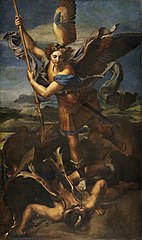| The Archangel Michael | |
|---|---|
| Greek: Ο Αρχάγγελος Μιχαήλ, Italian: L'Arcangelo Michele | |
 | |
| Artist | Theodore Poulakis |
| Year | c. 1640–1692 |
| Medium | tempera on wood |
| Movement | Heptanese School |
| Subject | The Archangel Michael |
| Dimensions | 76 cm× 54.3 cm(29.92 in× 21.37 in) |
| Location | Benaki Museum, Athens, Greece |
| Owner | Benaki Museum |
| Accession | ΓΕ 3007 |
| Website | Official Website |
The Archangel Michael was created by Greek painter Theodore Poulakis. He was also a teacher. He was affiliated with Greek painter Philotheos Skoufos. Poulakis was active on the Ionian Islands and Venice. He studied painting in Venice for over a decade. He was also involved with Venetian politics. He was a member of the quarantia. He was a representative of two schools, the Cretan School and Heptanese School. He is considered one of the founding members of the Heptanese School along with Elias Moskos. One hundred thirty of his paintings survived. [1]
Contents
The Archangel Micheal is a biblical figure associated with the old testament. The earliest surviving documented usage of his name is from 3rd and 2nd-century Hebrew texts. He is often associated with the apocalypse. He is often the chief of the angels and archangels. He is typically responsible for the care of humanity. [2] [3] [4] [5] Christianity adopted old testament traditions concerning the Archangel. [6] Michael is mentioned explicitly in Revelation 12:7–12, [7] where he battles Satan. [8] He has been depicted in Greek Italian Byzantine art since the dawn of the new religion.
Cretan Renaissance art and Baroque Roccoco Ionian art was heavily influenced by Italian art. One exemplary depiction of the Archangel was completed by Italian painter Raphael in his world-famous painting entitled St. Michael Vanquishing Satan . Elias Moskos also completed a version of the Archangel. Poulaki's version is a blend of both Italian and Greek prototypes. The work of art lies on the boundary of the Late Cretan School and Early Heptanese School. The work of art is at the Benaki Museum in Athens Greece. [9] [10]



